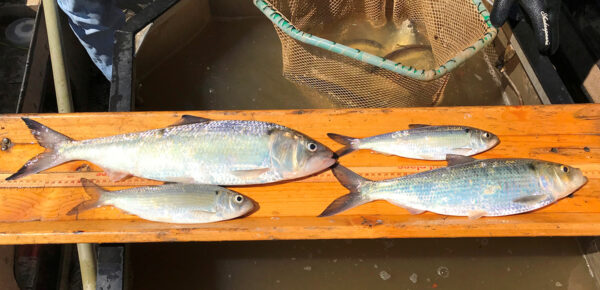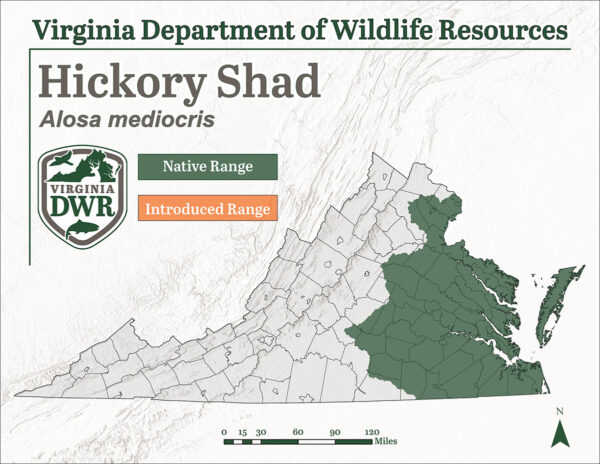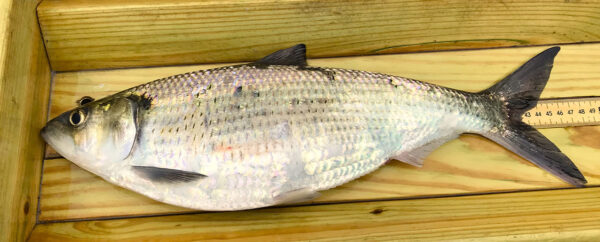Fact File
Scientific Name: Alosa mediocris
Classification: Fish, Order Clupeiformes, Family Clupeidae
Size: Hickory Shad can surpass 20 inches in length
Life Span: Hickory Shad can live up to 10 years
Identifying Characteristics

An adult Hickory Shad. ©Tim Aldridge
- Elongated and deep bodied from the side, but quickly tapering near the tail
- Lower jaw protrudes beyond the upper when the mouth is fully closed
- Silver in color along the sides, with hues of purple and blue in certain lighting
- An elongated anal fin in the shape of a sickle
- A sharp keel along the underside
How to Discern from Similar Looking Species
- Hickory Shad are often larger than the two river herring species in Virginia (Alewife and Blueback Herring)
- Hickory Shad have an obvious underbite with a fully closed mouth, where American Shad have a terminal mouth

Four anadromous clupeids captured during a Virginia DWR Fish Passage efficacy survey. Moving clockwise across the specimens are an American Shad (top left), Blueback Herring (top right), Hickory Shad (bottom right), and an Alewife (bottom left). ©Photo by Alan Weaver – State Fish Passage Coordinator DWR
Diet
Juvenile Hickory Shad found in the freshwaters and tidal estuaries of Virginia feed on zooplankton and insect larvae. Adult Hickory Shad primarily consume shrimp, but will occasionally eat other organisms such as small fish as they migrate throughout the Atlantic Ocean.
Distribution:
In Virginia, Hickory Shad are native to tributaries of the Albemarle Sound, Chesapeake Bay and the Atlantic Ocean.

Habitat
The Hickory Shad is an anadromous species of fish, which means it spends most of its adult life in saltwater environments, but returns to Virginia’s freshwater tributaries in order to fulfill its reproductive cycle. Hickory Shad are pelagic while in marine environments. Upon entering freshwater tributaries, Hickory Shad migrate upstream in search of areas with clean flowing water. They often reside in deeper runs and river bends during this time.
Reproduction
Hickory Shad return to freshwater tributaries in Virginia each spring. Broadcast spawning typically occurs atop sandbars or rocky riffles in about 5 feet of water, usually beginning at dusk and lasting into the night.
Management
Virginia Marine Resources Commission
Hickory Shad within Virginia’s tidal tributaries, the Chesapeake Bay, and along the Atlantic Coast are managed by the Virginia Marine Resources Commission (VMRC). The Department of Wildlife Resources would like to remind anglers to familiarize themselves with VMRC regulations prior to recreating in these areas.
Last updated: July 18, 2024
The Virginia Department of Wildlife Resources Species Profile Database serves as a repository of information for Virginia’s fish and wildlife species. The database is managed and curated by the Wildlife Information and Environmental Services (WIES) program. Species profile data, distribution information, and photography is generated by the Virginia Department of Wildlife Resources, State and Federal agencies, Collection Permittees, and other trusted partners. This product is not suitable for legal, engineering, or surveying use. The Virginia Department of Wildlife Resources does not accept responsibility for any missing data, inaccuracies, or other errors which may exist. In accordance with the terms of service for this product, you agree to this disclaimer.


